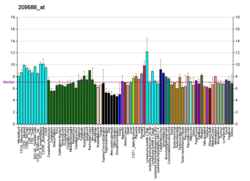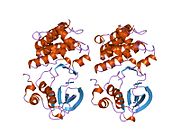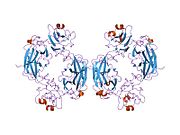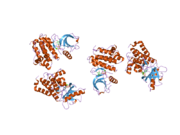Protein-coding gene in the species Homo sapiens
EPHB2 Identifiers Aliases EPHB2 External IDs OMIM : 600997 ; MGI : 99611 ; HomoloGene : 37925 ; GeneCards : EPHB2 ; OMA :EPHB2 - orthologs Wikidata
Ephrin type-B receptor 2 is a protein that in humans is encoded by the EPHB2 gene .[ 5]
Function Ephrin receptors and their ligands , the ephrins, mediate numerous developmental processes, particularly in the nervous system . Based on their structures and sequence relationships, ephrins are divided into the ephrin-A (EFNA) class, which are anchored to the membrane by a glycosylphosphatidylinositol linkage, and the ephrin-B (EFNB) class, which are transmembrane proteins . The Eph family of receptors are divided into 2 groups based on the similarity of their extracellular domain sequences and their affinities for binding ephrin-A and ephrin-B ligands. Ephrin receptors make up the largest subgroup of the receptor tyrosine kinase (RTK) family. The protein encoded by this gene is a receptor for ephrin-B family members.[ 6]
Animal studies EphB2 is part of the NMDA signaling pathway and restoring expression rescues cognitive function in an animal model of Alzheimer's disease .[ 7]
A recessive EphB2 gene is responsible for the crested-feather mutation in pigeons .[ 8]
Interactions EPH receptor B2 has been shown to interact with:
References
^ a b c GRCh38: Ensembl release 89: ENSG00000133216 – Ensembl , May 2017^ a b c GRCm38: Ensembl release 89: ENSMUSG00000028664 – Ensembl , May 2017^ "Human PubMed Reference:" . National Center for Biotechnology Information, U.S. National Library of Medicine .^ "Mouse PubMed Reference:" . National Center for Biotechnology Information, U.S. National Library of Medicine .^ Chan J, Watt VM (August 1991). "eek and erk, new members of the eph subclass of receptor protein-tyrosine kinases". Oncogene . 6 (6): 1057– 61. PMID 1648701 . ^ "Entrez Gene: EPHB2 EPH receptor B2" .^ Cissé M, Halabisky B, Harris J, Devidze N, Dubal DB, Sun B, Orr A, Lotz G, Kim DH, Hamto P, Ho K, Yu GQ, Mucke L (January 2011). "Reversing EphB2 depletion rescues cognitive functions in Alzheimer model" . Nature . 469 (7328): 47– 52. Bibcode :2011Natur.469...47C . doi :10.1038/nature09635 . PMC 3030448 PMID 21113149 . ^ Shapiro MD, Kronenberg Z, Li C, Domyan ET, Pan H, Campbell M, Tan H, Huff CD, Hu H, Vickrey AI, Nielsen SC, Stringham SA, Hu H, Willerslev E, Gilbert MT, Yandell M, Zhang G, Wang J (January 2013). "Genomic diversity and evolution of the head crest in the rock pigeon" . Science . 339 (6123): 1063– 7. Bibcode :2013Sci...339.1063S . doi :10.1126/science.1230422 . PMC 3778192 PMID 23371554 . ^ Yu HH, Zisch AH, Dodelet VC, Pasquale EB (July 2001). "Multiple signaling interactions of Abl and Arg kinases with the EphB2 receptor" . Oncogene . 20 (30): 3995– 4006. doi :10.1038/sj.onc.1204524 PMID 11494128 . ^ Holland SJ, Gale NW, Gish GD, Roth RA, Songyang Z, Cantley LC, Henkemeyer M, Yancopoulos GD, Pawson T (July 1997). "Juxtamembrane tyrosine residues couple the Eph family receptor EphB2/Nuk to specific SH2 domain proteins in neuronal cells" . EMBO J . 16 (13): 3877– 88. doi :10.1093/emboj/16.13.3877 . PMC 1170012 PMID 9233798 . ^ Zisch AH, Kalo MS, Chong LD, Pasquale EB (May 1998). "Complex formation between EphB2 and Src requires phosphorylation of tyrosine 611 in the EphB2 juxtamembrane region" . Oncogene . 16 (20): 2657– 70. doi :10.1038/sj.onc.1201823 PMID 9632142 . ^ Zisch AH, Pazzagli C, Freeman AL, Schneller M, Hadman M, Smith JW, Ruoslahti E, Pasquale EB (January 2000). "Replacing two conserved tyrosines of the EphB2 receptor with glutamic acid prevents binding of SH2 domains without abrogating kinase activity and biological responses" . Oncogene . 19 (2): 177– 87. doi :10.1038/sj.onc.1203304 PMID 10644995 .
PDB gallery
1b4f : OLIGOMERIC STRUCTURE OF THE HUMAN EPHB2 RECEPTOR SAM DOMAIN
1f0m : MONOMERIC STRUCTURE OF THE HUMAN EPHB2 SAM (STERILE ALPHA MOTIF) DOMAIN
1jpa : Crystal Structure of unphosphorylated EphB2 receptor tyrosine kinase and juxtamembrane region
1kgy : Crystal Structure of the EphB2-ephrinB2 complex
1nuk : CRYSTAL STRUCTURE OF THE LIGAND-BINDING DOMAIN OF THE EPHB2 RECEPTOR TYROSINE KINASE
1sgg : THE SOLUTION STRUCTURE OF SAM DOMAIN FROM THE RECEPTOR TYROSINE KINASE EPHB2, NMR, 10 STRUCTURES
1shw : EphB2 / EphrinA5 Complex Structure
2hen : Crystal Structure of the EphB2 Receptor Kinase domain in complex with ADP
Activity Regulation Classification Kinetics Types
Angiopoietin CNTF EGF (ErbB)
FGF
FGFR1 FGFR2
Agonists: Ersofermin FGF (1 , 2 (bFGF) , 3 , 4 , 5 , 6 , 7 (KGF ), 8 , 9 , 10 (KGF2) , 17 , 18 , 22 )Palifermin Repifermin Selpercatinib Sprifermin Trafermin FGFR3 FGFR4 Unsorted
HGF (c-Met) IGF
LNGF (p75NTR ) PDGF RET (GFL)
SCF (c-Kit) TGFβ Trk
TrkA
Negative allosteric modulators: VM-902A TrkB
Agonists: 3,7-DHF 3,7,8,2'-THF 4'-DMA-7,8-DHF 7,3'-DHF 7,8-DHF 7,8,2'-THF 7,8,3'-THF Amitriptyline BDNF BNN-20 Deoxygedunin Deprenyl Diosmetin DMAQ-B1 HIOC LM22A-4 N-Acetylserotonin NT-3 NT-4 Norwogonin (5,7,8-THF) R7 R13 TDP6 TrkC
VEGF Others
Additional growth factors: Adrenomedullin Colony-stimulating factors (see here instead)Connective tissue growth factor (CTGF) Ephrins (A1 , A2 , A3 , A4 , A5 , B1 , B2 , B3 )Erythropoietin (see here instead)Glucose-6-phosphate isomerase (GPI; PGI, PHI, AMF) Glia maturation factor (GMF) Hepatoma-derived growth factor (HDGF) Interleukins /T-cell growth factors (see here instead)Leukemia inhibitory factor (LIF) Macrophage-stimulating protein (MSP; HLP, HGFLP) Midkine (NEGF2) Migration-stimulating factor (MSF; PRG4) Oncomodulin Pituitary adenylate cyclase-activating peptide (PACAP) Pleiotrophin Renalase Thrombopoietin (see here instead)Wnt signaling proteins Additional growth factor receptor modulators: Cerebrolysin (neurotrophin mixture)
This article incorporates text from the United States National Library of Medicine , which is in the public domain .
















